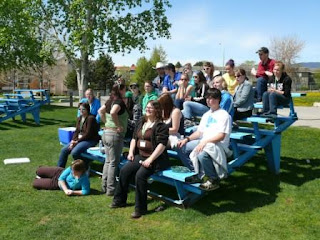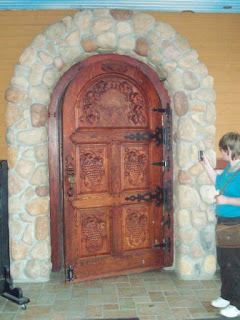

Monday morning had us all unloading from the bus at Davison’s Orchard. Tom Davison himself was there to see us. Tom’s family has owned the 60 acre orchard since 1933. They are now producing a plethora of tree fruits and vegetables to stock the successful market and bakery that Tom started when he took the farm over. There is also a delicious café and lots of gifts to take home to the family. Tom took us all on a tractor tour through the orchard.

The apple carts on the tractor ride

He explained that his orchard is actually in the middle of a microclimate, and it's in fact the hottest and driest piece of land in all of the Okanagan. He also went on to say that the most important factor in the Okanagan is Lake Okanagan. He explained that the only reason vineyards and orchards survive here is because the lake mediates the temperature, so it never gets too cold or too hot for the crops. At the end of the ride, one delegate asked if Tom considered his produce organic; you could tell he had been waiting for this. He puts it this way: “We are not organic, but let me tell you, we treat the land with the highest respect and are extremely careful with what we put on it. Our focus is on providing fresh, delicious produce that can be consumed the same day it was harvested.”
Well, that sounds good enough for us!

Tom Davison
The Farm Market
Spending time at Davisons


Then it was back on the bus to travel to Kelowna where we met four Farm Credit Canada (FCC) employees at a park for lunch. We learned that FCC is 50 years old and that it is special to Canada. The best business conductor for them is word of mouth in getting new clients and they also work hard to keep business relationships. It was interesting to learn that the business works with big accounts and numbers but also communication skills are really important.




Then it was back on the bus to travel to Kelowna where we met four Farm Credit Canada (FCC) employees at a park for lunch. We learned that FCC is 50 years old and that it is special to Canada. The best business conductor for them is word of mouth in getting new clients and they also work hard to keep business relationships. It was interesting to learn that the business works with big accounts and numbers but also communication skills are really important.


Next stop was Orchard Corners Emu Farm. Ken Reiger owns it as a third generation farmer. On his property, he grows all organic apples, cherries and blueberries. He also farms emus. This 15 acre farm is where Ken has lived since birth.

Emus came from Australia some 40 years ago. At the beginning of the industry a breeding pair was worth about 30 to 40 thousand dollars. These birds lay their eggs every 3 days. The male emu incubates the eggs. Emus have a hump on their backs that is 3 inches of fat! This is why the meat of an emu has no fat. The fat is made into an oil which prevents scar tissue from forming. These birds have huge eggs - the yolk is the size of a tennis ball and they take about 1.5 hours to boil.

Checking out the robotic tractor

In motion: it has a guide along the last line of turf cut, then cuts it in 6 foot sections, rolls it and lifts 5 rolls at a time onto a pallet.

A rejected piece of turf that ripped while it was being cut



Emus came from Australia some 40 years ago. At the beginning of the industry a breeding pair was worth about 30 to 40 thousand dollars. These birds lay their eggs every 3 days. The male emu incubates the eggs. Emus have a hump on their backs that is 3 inches of fat! This is why the meat of an emu has no fat. The fat is made into an oil which prevents scar tissue from forming. These birds have huge eggs - the yolk is the size of a tennis ball and they take about 1.5 hours to boil.
An emu egg
As for the fruit and berries on the farm, they are purely organic. It took about 3 years to work toxins out of the soil as the farm transitioned to organics. Ken says that because of pollution, it is hard for anyone to go 100% organic.


He decided to go organic when he was putting Roundup on the field and about 2 weeks later he saw a small mouse with a tumor on its back. Convinced that it was the chemicals that caused this deformity he switched to organic. Every year Ken volunteers his house and farm to the WOOF (Willing Workers on Organic Farms) program. All folks that work on his farm love it. It was fascinating to learn about Ken’s farm and perhaps one of us will go back via WWOOF.


He decided to go organic when he was putting Roundup on the field and about 2 weeks later he saw a small mouse with a tumor on its back. Convinced that it was the chemicals that caused this deformity he switched to organic. Every year Ken volunteers his house and farm to the WOOF (Willing Workers on Organic Farms) program. All folks that work on his farm love it. It was fascinating to learn about Ken’s farm and perhaps one of us will go back via WWOOF.
Grafting a fruit tree


Enjoying emu sausage and jerky

Next stop was the Clement Turf Farm, where we learned about the turf industry. There is a lot that goes into making turf including water and time. It takes approximately 12-14 months from start to finish to have the turf product. The industry has gone from hand cutting the turf with scissors to a fully automated robotic machine. We got to see the robotic machine in operation, and there are only 2 of them currently in BC.
Irrigated field on the way up the driveway


Enjoying emu sausage and jerky

Next stop was the Clement Turf Farm, where we learned about the turf industry. There is a lot that goes into making turf including water and time. It takes approximately 12-14 months from start to finish to have the turf product. The industry has gone from hand cutting the turf with scissors to a fully automated robotic machine. We got to see the robotic machine in operation, and there are only 2 of them currently in BC.
Irrigated field on the way up the driveway

Checking out the robotic tractor

In motion: it has a guide along the last line of turf cut, then cuts it in 6 foot sections, rolls it and lifts 5 rolls at a time onto a pallet.

A rejected piece of turf that ripped while it was being cut


The last stop of the day was at Summerhill Winery. We learned about wine production and that their signature wine is their sparkling wine. Ice wine is also one of their specialties and a lot goes into making it.
Sparkling wine
We also got to experience the negative ions in the pyramid that they claim make the wine taste better.
Success!







































